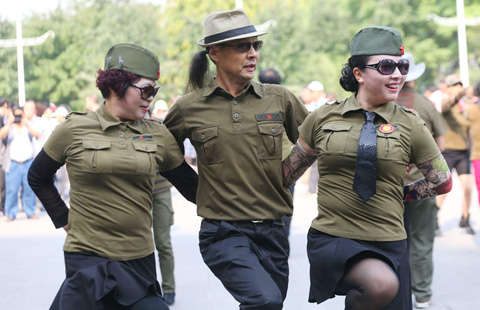
The stigma surrounding leprosy is fading in China as the public gains greater knowledge and understanding of the disease. However, many challenges still remain, as Erik Nilsson and Yan Yiqi report from Deqing, Zhejiang province.
When Xu Xiaotong was 11, his neighbor urged other villagers to set him on fire - just because the boy tried to go to school.
"I was eager to study like the other kids, but ..." Xu, now 69, said, recalling the incident.
Xu had leprosy, and his neighbor was terrified that he would infect the other children. In those days, the strains of both prejudice and leprosy were far more virulent. "I recently returned to the village," he said. "The people were very kind."
The intervening years provided plenty of time for study, and Xu has learned to read and write. He also taught himself to compose music on the erhu - a two-stringed Chinese instrument - and pen lyrics. Now, he's studying to gain a nursing qualification.
Xu proudly displayed a photo of himself with Politbureau member Liu Yandong. "I never imagined someone so important would want to meet me," he said. "I've never even considered living in society. This is home."
Home truths
"Home" is the leprosy village in Deqing county, Zhejiang province, which houses 84, mainly elderly, patients. Most are disabled because they hail from a time before effective diagnosis and treatments dramatically reduced the number of people severely affected by the disease and its after-effects.
About 110,000 people in China are disabled by leprosy, and about 250 of them live in 12 treatment villages in Zhejiang, according Wang Jingquan, the chief director of Xu's village, which is administered by Shangbai hospital under the Zhejiang Institute of Dermatology. "Most don't have enough care or subsidies," he said.
Between the hospital's foundation in 1876 and the end of 2014, the province recorded 16,785 cases of leprosy. Last year, there were just 25 positive diagnoses.
In 2001, the central government announced an ambitious plan to eradicate the disease by 2020, but it's been an uphill struggle. "It's a difficult task, because some (patients) live in remote, mountain villages," Wang said.
In 2011, Zhejiang developed a provincial-level dermatological database, which resulted in the average diagnosis time falling to 16 months, compared with the national average of two years. "Fewer people are becoming disabled now, because we can detect the disease earlier," said Yan Liying, the dermatological institute's director.
The average age of the patients is 75, and they have been in the village for an average of 30 years each. "There are very few newcomers," Yan said. Newly diagnosed patients take medicine at home or at their local hospitals.
"The greatest problem is no longer leprosy itself, but the disability and disfigurement that occur after it's cured," Yan said, adding that skin problems such as ulcers and an inability to sweat mean the patients need extra care. Many have seen their feet either eaten away by disease or partially amputated, and "claw finger" is a common complaint. Mental problems, mainly depression, are widespread.
'Reptile eye'
The patients are visually impaired, too. The bacteria that cause leprosy damage the nerves that control blinking, so eye drops must be administered every few minutes to prevent the patients' corneas from drying out and causing blindness. The residents wear special eye masks when they sleep.
The medical staff members unapologetically use the term "reptile eye" to describe the unblinking gaze of older patients, who usually wear sunglasses and baseball caps to protect their sight.
Despite the challenges, some have excelled. The centerpiece of Xu's dormitory wall is a triptych of beautiful paintings created by his now-deceased neighbor, who held the paintbrushes in his mouth or the crook of his wrist. Meanwhile, Xu has written more than 20 songs about the disease, including People with Leprosy Singing, Warm Sunshine on Us, and Angel of Leprosy.
Xu was 6 when red blotches appeared on his skin, but he wasn't diagnosed until three years later. His father died when he was 4, so his mother had to cope with the stigma on her own. "She was shocked and afraid," Xu recalled.
He was sent to the leprosy village at age 9, but was sent home after a month and medicine was mailed to him. However, in 1974 he returned to the leprosy village for good.
The patients were once shunned, but now they have regular contact with local residents. "People from nearby villages invite us for meals and they come here to eat, too," Xu said. The villagers also send cars to take him to weddings, and their children study the erhu under his tutelage. "I hope more outsiders will learn about leprosy and realize it's not scary," Xu said. "People should treat us as equals."
Yan said that despite greater public acceptance, discrimination still exists. "Professional barbers won't cut the patients' hair, but university student volunteers will."
Buried alive or banished
In less enlightened times, people with leprosy were often buried alive or banished to perish in the wilderness. As recently as the 1980s, patients were kept in isolation and the doctors who treated them wore biohazard suits.
In 1985, China began using medication provided free of charge to member countries by the World Health Organization. The drugs replaced traditional Chinese medicines, which relieved the pain and slowed the advance of the disease but couldn't cure it. About 70 percent of the patients show obvious facial signs of having been "shaped" by leprosy, according to Yan.
Old age and discrimination mean the residents are unable to work outside the village, so the provincial government pays their medical costs, provides 745 yuan ($120) in monthly welfare, and subsidizes amenities such as air conditioning and TV.
Patients are also offered regular psychotherapy sessions. Even so, a group of about 10 regularly attack the doctors, sometimes even beating them with sticks. "I lock my door at night because of them," Wang said.
Staff members use treats to coax violent patients to take medication, but if that fails they resort to injections. "The patients sleep for two or three days afterward," Wang said.
Despite their tough lives, most of the residents are content. "Life's good here," said Gu Youliang, a 64-year-old who has been at the center for 48 years.
Gu was 17 when he was diagnosed, and his brother and brother-in-law carried his bed over the mountains for three days to reach the center. "I'd heard that people who came here never came out. But the doctors and nurses are so kind. They make my bed. They bring my meals. My brother-in-law says I have a better life than he does!"
Every patient gives the same reason for the greater social acceptance: Shafick George Hatem, a US physician who worked on the disease in China, and was the first foreigner to be granted citizenship of the People's Republic of China.
"I'm grateful he told people that leprosy is curable and they shouldn't be afraid of patients," said Zheng Jiansong, the center's youngest resident. The 49-year-old was diagnosed at age 11 and cured at 26, but it was too late to save his feet, which had already been ravaged.
"I returned to my village after I was cured," he said. "The doctors told the village leaders the disease wasn't contagious, but people still treated me differently, and my neighbors were scared by the ulcers on my legs."
He worked in factories for a short time, but eventually moved to the village, where he earns about 700 yuan a month by working in the laundry. "I had no choice but to come here because of my feet," he said. "I hope people with symptoms seek immediate treatment so they don't end up disabled. They can still work if they're not disabled."
He recalled the day he arrived: "I remember it clearly. It was Jan 8, 1983. It was snowing. I saw some patients and hid behind my mom. I'd never seen people like them before. I thought my life was over, and considered suicide. But the doctors and nurses were nice. I got over it in a few months. I'm not one to overthink things."
Even the medical workers treated patients differently back then. "The doctors wore biohazard suits with masks and gloves," he said. "It's very different now."
Fifty years of change
Zhang Caibao has seen plenty of changes during her 50 years at the center. The 91-year-old was diagnosed at age 29, but she didn't arrive at the village until more than a decade later.
"I never went home again," she said, sitting in her wheelchair. "I haven't returned because my son's wife is ill. They live up a flight of stairs. I can't do stairs."
She complained that her eyes hurt, so the nurses gave her some drops. "I'm satisfied with life," she said.
Her great-grandson visited recently, but he's the exception that proves the rule - families tend to avoid relatives with the disease. "Some families don't visit for a whole year. They don't understand," Nurse Pan Mei'er said.
Pan, who was awarded the Florence Nightingale Medal and introduced to then-president Hu Jintao in recognition of her devoted nursing career, said she understood why families are unwilling to visit sick relatives. Her husband works as a researcher at the village, and some of their friends have expressed concerns. The private lives of many of the medical staff members have been disrupted because of their involvement with the patients, and few of them are married.
Wang, the chief director, said his wife often voices objections. "I once cut myself when I was trimming a patient's fingernails," he said. "My wife was angry because she was afraid I'd get leprosy. She's forbidden me from clipping patients' nails, but I do it anyway. Their fingers curl into their palms and will slice into the flesh if the nails aren't cut."
He believes outsiders can learn a lot from the patients. "Their lives are hard, a real struggle, but they remain optimistic. We could learn a lot from them."
Contact the writers through erik_nilsson@chinadaily.com.cn
|
A doctor with the Zhejiang Institute of Dermatology pays regular visits to patients in the leprosy village in Deqing, Zhejiang province. Photos by Gao Erqiang / China Daily |
|
The chronic disease results in many patients contracting "claw finger". |
|
Tang Jinchu (left) and Cai Haiqiu, two residents of the leprosy village, married after they were both cured of the disease. |
|
Following in the footsteps of her grandfather, who also worked at the center, Liu Dun has been caring for patients in the leprosy village since 2012. |
(China Daily 05/26/2015 page6)








